| 1 | Fiji: yellow-lipped sea krait |
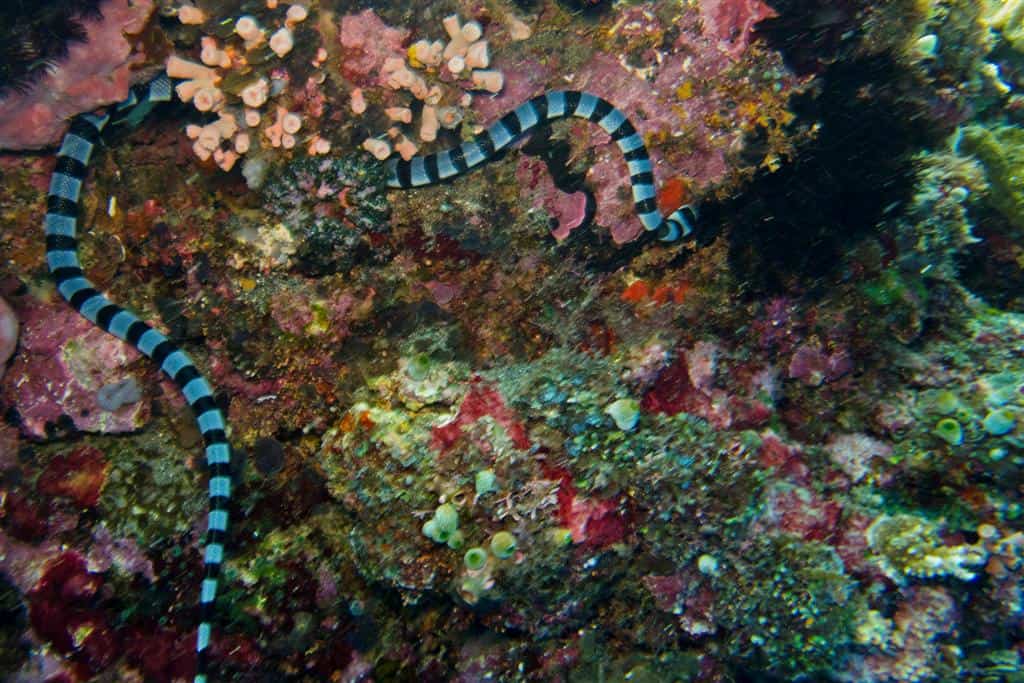
Fiji was randomly selected due to being a remote island paradise. You’d expect that this exotic country would be a vast kaleidoscope of giant pythons and multicoloured, stealthy vipers plotting to destroy you, but the country has only a handful of venomous snakes.
The deadliest one is relatively friendly to humans. It’s called the yellow-lipped sea krait, or the banded sea snake, and occurs across Oceania from Vietnam to New Zealand. It lives on coral and rocky reefs, and is a sea snake with a flattened tail that allows it to paddle around.
Unlike most sea snakes, adults spend 50% of their life on land, although compared to in the water, its speed is slashed to 20%. Females are much longer than males, averaging at 142cm long compared to 87.5cm for males. Some biologists claim to have sighted 2 metre yellow-lipped sea kraits before. The snake also has a tail almost identical to its head, to scare away predators like sharks while it sticks its real head into coral reefs to feast.
Luckily, they rarely attack humans. The sea krait’s favourite food is eels, such as conger or moray eels, with a side helping of small fish. In fact, the yellow-lipped sea krait can swallow an eel twice its size. Afterwards, the snake can barely swim, and spends weeks lying on sandy beaches digesting.
Thankfully, they can’t swallow a human 50 times its size. Fishermen are most at risk; they’ve been known to accidentally haul up the snakes in their nets and get bitten when sifting through their catches.
On average, yellow lipped sea kraits bite one human per year, and nobody has died in living memory. However, their venom is extremely powerful, 10 times deadlier than a rattlesnake.
Each snake produces 10-15mg of venom and only a fraction of that is needed to end your life. An old myth has spread around Fiji that yellow-lipped sea kraits are harmless to humans because their jaw doesn’t open widely enough, but this is false. Don’t get lulled into a false sense of security!
Nevertheless, these snakes are docile and non-aggressive. If you’re terrified of snakes, then a nice cottage in Fiji may be in order.
| 2 | Argentina: painted lancehead |
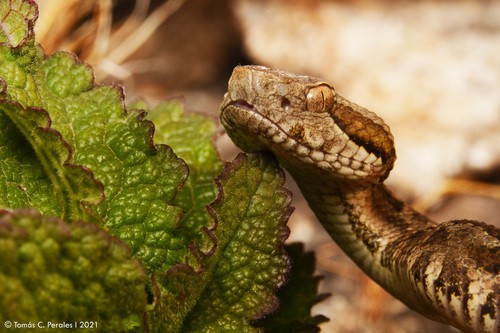
Argentina is a country of many extremes. In the far south, it’s like a western European country transplanted halfway across the world, but in the north, it’s a humid snakefest like any South American country. Northeast Argentina sees the most snake bites, with 96.6% coming from the Bothrops pitviper family, according to a study using data from 1978 to 1998. The most bite-happy species of all is Bothrops diporus, AKA the painted lancehead. This species has very few neurotoxins in its venom. But it covers almost everything else: a Bothrops diporus bite is highly haemorrhaging, proteolytic, and myotoxic, meaning that it assaults muscle tissue cells.
Attempting to kill this snake will make it extremely angry (not surprisingly really). The advice is simple: do nothing to agitate this viper. Make sure it doesn’t notice you if possible. If you’re strolling past, then keep going, unless it’s blocking the path, in which case you should turn 180 degrees. If the viper is slithering past as you sit on a picnic bench, freeze still and let it slither on. Painted lanceheads are confirmed to eat other snakes as well, munching on their fellow kind, including chacho sipo snakes.
The main cause of death with painted lanceheads is kidney failure. It covers virtually all local symptoms, including swelling, intense pain, blistering, necrosis and haemorrhage. Despite most of Argentina running as fast as possible from this snake, there are still dedicated keepers who think they’re adorable. Painted lanceheads are relatively small at 60-70cm for males, and females reaching 110cm.
| 3 | USA: eastern diamondback rattlesnake |
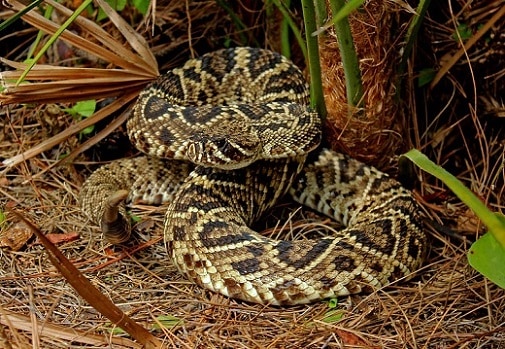
The deadliest snake in the USA by number of fatalities, and the deadliest rattlesnake worldwide too. Also the heaviest snake in the USA, although not the longest. Yet another US record is the eastern diamondback’s 1 inch fangs, the longest in proportion to its body of any rattlesnake species.
It was first discovered in 1799, and since then has outstripped the western diamondback rattlesnake for most recorded kills. The longest one ever recorded was 244cm, while the average is 83-184cm. This snake lives in sandy woodlands and coastal scrubs in southern US states.
Their fangs are sharp, curved, and have hinges which fold within the mouth when not in use. Usually, eastern diamondback rattlesnakes retreat from humans, but when threatened (or perhaps bored), they can spring at you over a third of their body length. Their venom is a poisonous soup of 95 different proteins and enzymes.
Life as an eastern diamondback is pretty sweet; they have a powerful swimming ability, infrared sensing powers, and keen night vision. All this makes them a deadly predator, despite not actively seeking out humans. Their personalities are particularly unpredictable, as while many snakes rattle their tails as their traditional warning bell at about 25 feet away, other snakes will wait until you’re much closer.
| 4 | England: adder |
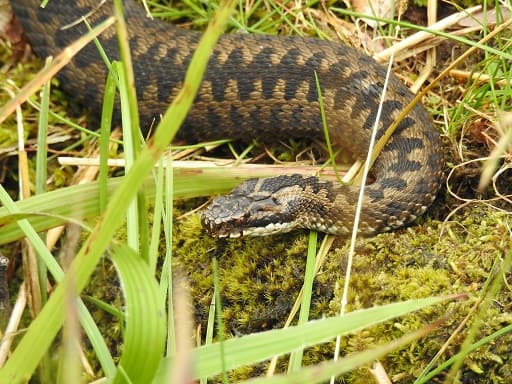
The best that England can do is the 60cm long, brown and beige zig-zagged adder, a snake that hasn’t killed anybody in 40 years.
The adder is the only venomous snake in England and one of only three snake species, alongside the green-coloured grass snake and the rare smooth snake. Adders are found in heathland and woodlands and hibernate in winter. Bites are most common from July to August and mostly happen when curious people foolishly pick them up or bend down to say hello.
The adder has something of a taste for humans, biting 50-100 people yearly, in addition to 50-100 dogs, but its venom is relatively weak. If the common European adder sinks its teeth in your arm, the effects will show up from within a few minutes to an hour. You’ll probably experience nausea, vomiting, swollen lips and itchy skin. You might get mentally confused, dizzy or disorientated. You might even die. Adders have only killed 14 people in England since 1876, and nobody since 1975, but a few patients were clinging to life by their fingertips.
One third of adder bites are dry bites where the snake doesn’t inject any venom at all, just two painful puncture marks. Pointlessly, the NHS lists “anxiety” as a symptom of a dry bite – what are you going to do, pat the adder on the head affectionately as it bites your arm?
An adder could possibly kill you if your body’s detoxification systems had a rare and unlucky genetic weakness, or if the snake was the king of the adders, a super enhanced new species with stronger venom (or maybe a government experiment gone wrong). In rare cases, adders can actually be pitch black, but they’re not known to be the adder from hell or anything.
| 5 | Thailand: blue krait |
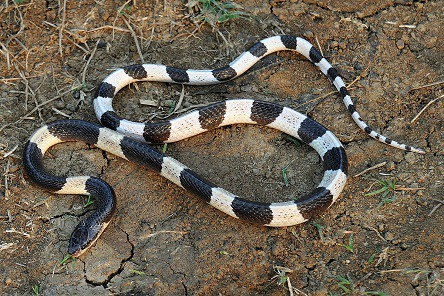
This is the snake that doesn’t know its own strength. Its venom is among the deadliest, the most toxic and corrosive in the whole world, yet the blue krait is surprisingly timid.
This white coloured, 100cm long serpent is a creature of the dampness and water, found by ponds, rivers and lakes in rural India. The blue krait also enjoys fields, holes and buildings, but doesn’t enjoy the sunshine; they’re easily the most active during the first half of the night.
The blue krait’s menu consists of lizards, mice, rodents, but mainly other snakes. The blue krait is a cannibal, and boasts venom 16 times more powerful than that of a cobra. Only 10mg is released in a bite, compared to 40-70mg for Russell’s viper. Yet the venom is rich in neurotoxins and paralysing agents, and first produces the symptoms of nausea and vomiting.
Soon after, muscle paralysis kicks in, followed by a last gasp of massively overexcited muscle spasms, cramps and tremors. The next stage is complete and total paralysis, and finally, respiratory failure. This is accompanied by a helping of madness, for the blue krait’s venom alters your mind and removes your ability to think clearly. The last thing you want is to be attacked by a blue krait with nobody around to assist you.
What’s strange is that unlike the painted lancehead, a blue krait bite is reportedly painless. It’s relatively timid and tends to flee from humans and slither away into the undergrowth.
| 6 | Costa Rica: fer-de-lance |
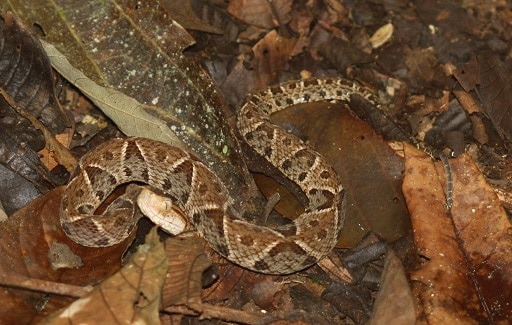
Responsible for 42-46% of snake bites in Costa Rica. Life is good as a Bothrops asper, with a wide menu that includes geckos, rodents, opossums, rabbits and even crayfish. Bothrops asper is a prosperous, widespread snake, found in Belize, Colombia, Costa Rica, Ecuador, Guatemala, Honduras, Mexico, Nicaragua, Panama, and Venezuela.
When it comes to humans, Bothrops asper combine three deadly factors. Firstly, Bothrops asper has no fear of human settlements. Banana farms are particular havens because they’re so packed with rats. This snake also likes to spend the whole day coiled up by rural dirt tracks, meaning that Costa Rican villagers are constantly tiptoeing around.
The venom, meanwhile, is packed with an anticoagulant that causes severe haemorrhaging. Around the bite you can expect swelling, pain necrosis. Around your body you can expect abdominal pain, dizziness, headaches, collapses, and a 20% chance of death if you fail to take the antivenom. The anticoagulant properties are under investigation as a drug, so don’t be surprised when your scientist saviour actually studies you with a clipboard after injecting.
The final factor is its nervous disposition. Bothrops asper is very unpredictable. They might decide to flee and enjoy a nice rodent for tea, but they might decide to randomly spring at your face with their fangs bared.
This snake is good at pouncing too, requiring no coil. When it does attack, it often attacks repeatedly. What you have to do is listen for a buzzing sound, the vibrations of its tail, a sign of the snake’s agitation.
The average Joe of Bothrops aspers is 120-180cm long, but biologists swear to have seen 240cm snakes slithering around the jungle. Bothrops asper also rules the Venezuelan state of Lara, causing 78% of all snakebite fatalities, and the Colombian regions of Antioquia and Chocó, causing 50-70% of total snake bites.
| 7 | Saudi Arabia: puff adder |
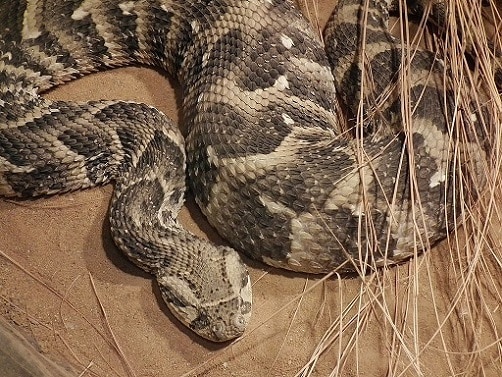
Named because it puffs its body up in a display of defiance before launching into the air and sinking its teeth into your arm. The puff adder is mostly an African snake, but its territory stretches into the southwest of the sun-baked desert kingdom of Saudi Arabia (and Yemen) as well. Amazingly, it’s actually deadlier than the black mamba. The puff adder can release 150-250mg of venom in a single bite, with a record of 750mg. Guess how much is needed to kill a human? 100mg.
The 1 metre long puff adder is also an extraordinarily fast snake. Its teeth can move from the desert floor to your arm in just 0.25 seconds. Its sandy black-beige camouflage is legendary, and that’s partly why it attacks so many people. As a species, its fleeing instinct is lower than usual because it’s so used to being hidden, and consequently, it encounters humans frequently.
The puff adder’s venom can kill you within a day. The venom is so necrotic that the flesh surrounding the bite mark can rot away down to the bone.
The puff adder’s mortality rate depends on the bite. A serious injection of venom has a 50% mortality rate, while a standard bite gives you a 15% risk of death (without antivenom). The baby snakes are also venomous and have fangs just as sharp as their parents.
The puff adder will hiss loudly before attacking, and suddenly break into a rapid s-shaped slithering movement. Usually, they’re slow snakes due to their stocky bodies, but when threatened the puff adder accelerates rapidly. Saudi Arabia has 50 different snake species, including the carpet viper and Arabian cat snake, but the puff adder is the one which haunts people’s dreams.
| 8 | Cyprus: blunt-nosed viper |
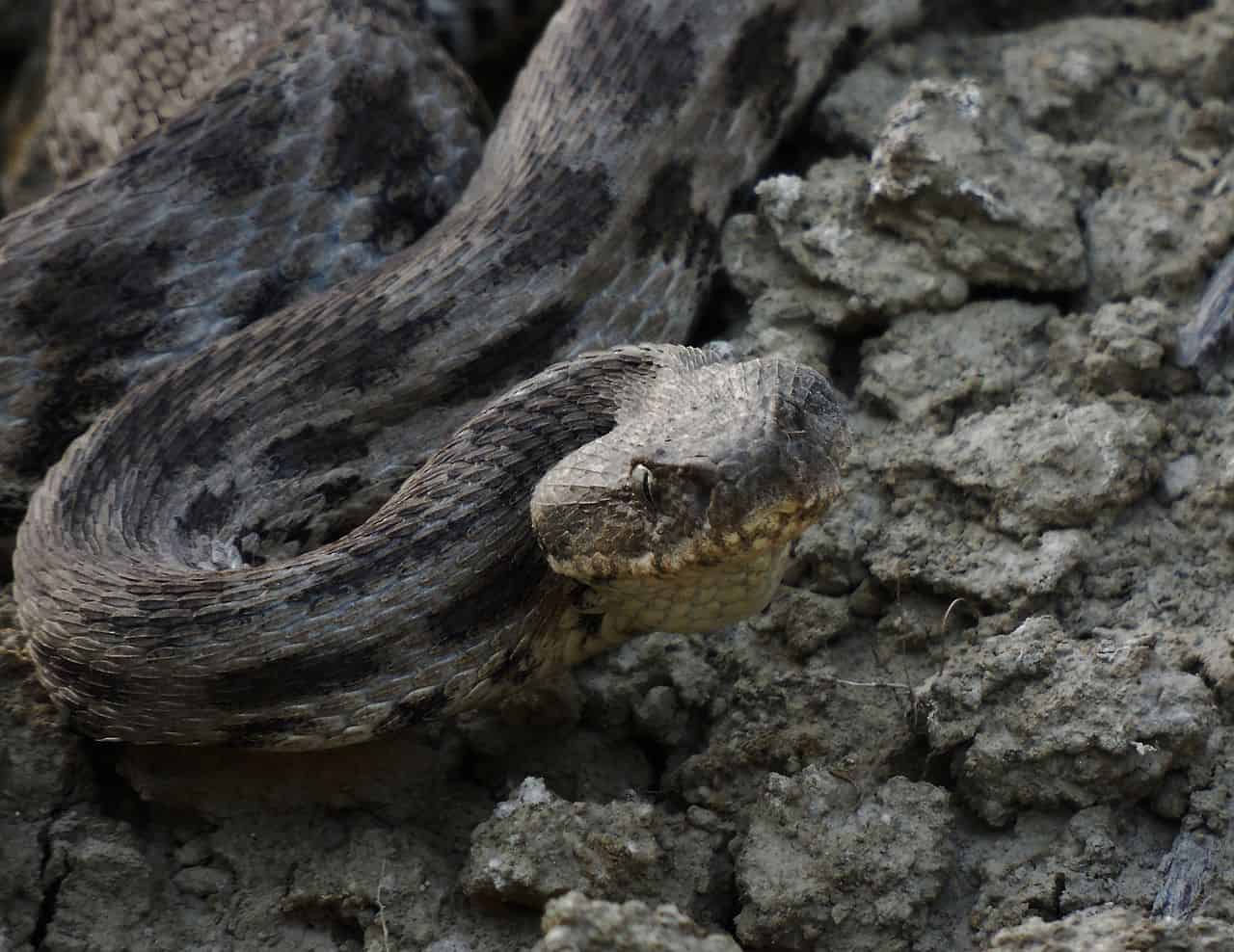
The island of Cyprus has 14 different snakes in total, including 3 venomous snakes. The Montpellier snake and cat snake pose no threat to human beings whatsoever, due to their backwards tilted fangs that can’t sink into human flesh properly.
The blunt nosed viper, meanwhile, is slightly different. It has 1cm long hinged fangs which slot neatly into the roof of its mouth, and are angled perfectly to sink into your arm.
It’s the only snake in Cyprus which is capable of killing a human, but falls into the same category as England’s adder. While there are 20 attacks on humans per year on average, nobody has died for 15 years.
The blunt-nosed viper is a fat snake measuring 1.3 to 1.7 meters long. It has a beige, rectangular pattern on its back with a silvery underlying colour, with black spots on its head; all in all, its one of the more camouflaged snakes around. There’s 5 different subspecies, including a Syrian variety.
In reality, the blunt nosed viper has nothing against us humans. Its normal habitat is rocky areas and grassy meadows and plains without trees. However, it loves water, and has a tendency to end up in people’s swimming pools.
Unlike Thailand’s blue krait, the bite is extremely painful, alerting you to the threat. The fangs actually stay embedded in your skin to pump venom, followed by a rapidly appearing symptom of an increased heartbeat, ingeniously designed to pump the venom around even further. The blunt-nosed viper’s main trick is destroying erythrocytes and causing blood to coagulate.
While death is rare, serious cases continue. In 2017, a 55 year old man was hospitalised in a critical condition after being bitten, while in 2004, a 4-year old boy almost died after picking up a blunt nosed viper and being bitten.
Within minutes, the boy’s eyes were rolling as he had a cardiac arrest, and he was actually clinically dead as the ambulance transported him away. The boy’s mother was asked to describe the snake at the hospital, and she recalled a look of dread that appeared on the doctors’ faces. Soon though, the Cyprian expertise revived the 4-year old, with no lasting consequences.
| 9 | France: asp viper |
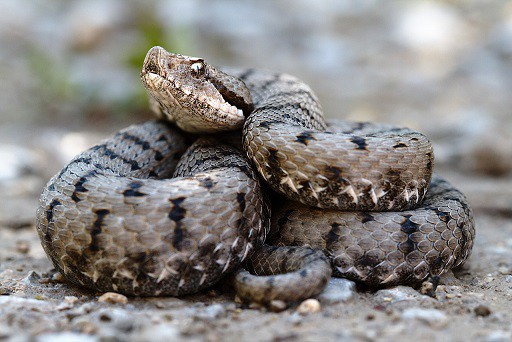
The deadliest snake of France pales in comparison to the puff adder, but it’s much deadlier than England’s adder, boasting a fatality rate of 4% if bites are left untreated.
The entirety of France is in the grip of this terror, with only the extreme north and northeast having no asp vipers. You can find the asp viper (Vipera aspis) in the evening, stalking its prey and venturing directly into their hidey holes. Sometimes, the asp viper eats every last animal inside the hole and seizes the lair for itself.
Compared to the rest of this list, the asp viper is a small snake. It’s surprisingly thick, with a classic viper triangular head, but its maximum length is just 75cm and its average length is 20-30cm.
Of course, the asp viper might prefer to be stealthy anyway, and their favoured technique is to lie in wait like a rattlesnake. Young ones feed on lizards almost exclusively, while adults enjoy a banquet of rodents, lizards and even birds, taking a week to digest a single animal.
Could you wake up inside the stomach of an asp viper one day? No chance, but their venom is pretty toxic. It’s just that it only injects 4.6mg to 20.1mg with one bite. Only children and the elderly are at serious risk. Dry bites are common, whereas a second bite, if you fail to take a hint, is more likely to be venomous.
Stage 1 symptoms include local swelling and pain. Stage 2 symptoms include massive swelling, low blood pressure and digestive troubles, while the life-threatening stage 3 involves diarrhoea and catastrophically low blood pressure.
The asp viper is a snake of low hills and mountains, with limestone rocks and dry soils. In the Pyrenees, it has been found at altitudes of 2100 meters. The asp viper kills its smaller prey within seconds, and bides its time while venom kills the larger prey. Asp vipers never eat fish or amphibians, despite commonly being found close to water.
| 10 | Vietnam: Malayan pitviper |
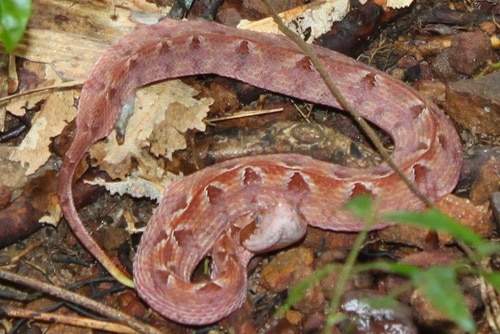
Snakes were the second great enemy Americans faced in the Vietnam war. A rustle in the jungle undergrowth was not necessarily the Vietcong, but a snake approaching, cautious about the intruder, and ready to bite if the soldiers looked at all threatening (and they often did). Today, Malayan pitvipers remain the number 1 cause of snakebite in Vietnam, just ahead of the monocled cobra.
This is a cocky snake which doesn’t even leave the area after biting humans. They can sit there smugly for hours afterwards, as they’re an extremely stationary species. Deaths aren’t common, but victims can be left with permanently swollen limbs. Malayan pitvipers are very inconsistent in their behaviour, dangerously so. One morning, they can be completely calm, before a sudden eruption of anger the next day leaves you with two fang marks and painfully erupting blisters. Malayan pitvipers fill a similar niche to cottonmouths in the USA, with a thick body and orange tint, and a liking for dry, leafy forests.
If a Malayan pitviper bites you on the hand, the odds of losing a finger are dangerously high. They’re mainly a nocturnal snake, but can also move during cool, overcast days.
